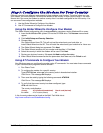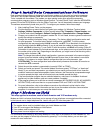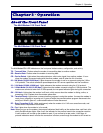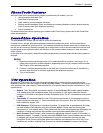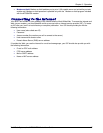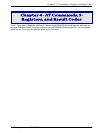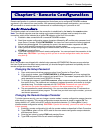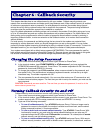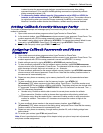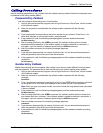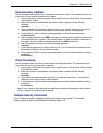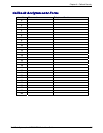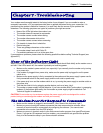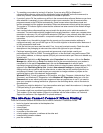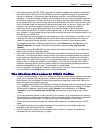
Chapter 6 - Callback Security
Multi-Tech Systems, Inc. MT5634ZBA-Series User Guide 21
is asked to enter the password again before a connection can be made. Also, dialing
command locations 0–3 for use with the DS=y dialing command are replaced by callback
dialing command locations 0–29.
· To temporarily disable callback security if the modem is set to #CBS1 or #CBS2 (for
instance, to call another modem): Type AT#CBS3 and press E
NTER. The modem returns to
its original setting when you issue the hangup command (+++ATH) or the modem is reset.
Note that if a remote modem breaks the connection, callback security remains disabled.
Setting Callback Security Message Parity
The modem’s password prompt and messages parity must match the parity of the computer to which the
modem is connected.
1.
Open a data communications program such as HyperTerminal or PhoneTools.
2.
In the terminal window, type AT#Sxxxxxxxx, where xxxxxxxx is your password. Press ENTER. The
modem responds with OK if the setup password is correct and ERROR if it is wrong.
3.
The modem’s parity default value is No parity (AT#CBP0). To change the modem’s default to use
even parity, type AT#CBP2. Press E
NTER. For odd parity, type AT#CBP1. Press ENTER.
4. To store the new parity value, type AT&W. Press ENTER.
Assigning Callback Passwords and Phone
Numbers
1. Open a data communications program such as HyperTerminal or PhoneTools.
2.
In the terminal window, type AT#Sxxxxxxxx, where xxxxxxxx is your password. Press ENTER. The
modem responds with OK if the setup password is correct and ERROR if it is wrong.
3.
Enable callback security by typing AT#CBS1 or AT#CBS2 and pressing ENTER.
4.
To store a callback password for the first callback memory location, type AT#CBN0=xxxxxxxx,
where xxxxxxxx is the first password. Press E
NTER. The password must be unique, must be six to
eight characters in length, and must not contain a + or - character.
5.
To store a callback password for the second callback memory location, type AT#CBN1=xxxxxxxx,
where xxxxxxxx is the second password. Press E
NTER. Note that the memory location number in
the command is incremented by one.
6.
Repeat as many times as necessary, up to memory location 29, until all passwords have been
entered.
7.
To store a callback phone number in the first memory location, type AT&Z0=[+][-
]ATxxxxxxxx[,???], where xxxxxxxx is the dialing string. Press E
NTER. The phone number must
be preceded by DT for tone dialing or DP for pulse dialing. The dialing string can also include other
AT commands. Example: AT&Z0=+-ATM0DT5551212. Up to 35 characters can be used. The +, -,
and ??? characters are optional:
+ Number entry. Enables a mobile caller to enter his current phone number for callback.
- Direct connection. Enables a caller to choose direct connection without being called back.
,??? Extension entry. Must be used with the + command. Enables a caller to enter an extension
number for callback. The number of ? characters must equal the number of digits in the
extension.
8.
To store a callback phone number in the second memory location, type AT&Z1=[+][-
]ATxxxxxxxx[,???], where xxxxxxxx is the dialing string, and press E
NTER. Note that the memory
location number in the command is incremented by one.
9.
Repeat as many times as necessary, through memory location 29, until all dialing strings have
been entered.
10.
To review your entries, type AT&V and press ENTER.
Note: A form is provided on the last page of this chapter to help you plan or keep track of password
and phone number assignments.



